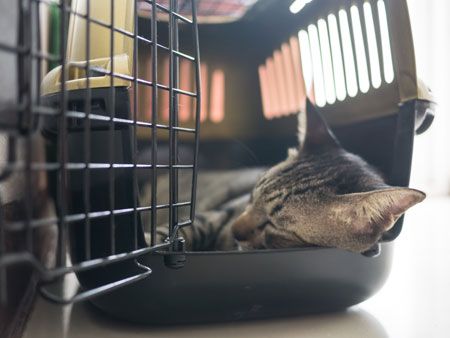Keep calm and carrier on with older cats
These Fear Free cat carrier tips complement the low stress measures youre taking in your veterinary clinic.

Shutterstock.com
Editor's note: This is the first in a series of stress-reducing tips that include strategies for pet owners to try at home before the pet reaches your clinic. Keep an eye on dvm360.com/InClinicAtHome for more topics such as nail trims, exam table woes and handling.
What's in the box? Another freaked out cat, with claws and teeth fueled by fear and fury. And you just can't wait to open that box, right?
What if there were another way? Good news: Even for mature cats who've learned to loathe their carriers with a white-hot passion, it may be possible to transition them to a more peaceful place with their carriers.
It's true that prevention is key to keeping animals comfortable and relaxed with veterinary care. But many cats have already missed out on the prevention, and they suffer from fear, anxiety and stress issues associated with veterinary visits.
Even for these pets it's not too late to help alleviate fear, anxiety and stress and make drastic improvements to protect their emotional experience during care. Emotionally protective veterinary care is geared to prevent fear, anxiety and stress, and to alleviate the feelings that already exist. Here are key ways to help cat owners complement your veterinary team's efforts to keep pets calm and carry on with emotionally protective care.
The veterinary team's role
> Ask your clients during visits if Felix ever hesitates entering the carrier when it's time to visit the veterinarian.
> Observe the cat's response to the carrier during the veterinary visit. Though cats may gravitate to the carrier space as their hideout in the veterinary office, many felines avoid it in their home space.
> Keep carrier conditioning tips on hand to give pet owners during their visit. Carrier training guidance is important, especially for preventing fear associated with the carrier. For cat owners facing established carrier fears, intervention is critical to ensure clients don't face a battle getting the cat inside-and to make sure the carrier doesn't become the barrier that keeps the cat from visiting for regular care.
The pet owner's role
> Clean the cat's carrier with a product that removes any lingering clinic smells after each veterinary visit. This reduces the scary smells that may remain in the space. Giving the pet owner a sample Rescue wipe can help. Pet owners can also use cleaners with mild smells such as a gentle unscented soap on the washable surfaces or a mild smelling detergent for washable soft carriers.
> Infuse feel-good pheromones in the carrier with pheromone sprays or wipes. Adding the cat's favorite blanket, bed or toys inside the carrier can make it feel like a safe, secure home base for the cat.
> Start fresh. In cases where fear or anxiety is high, or the carrier has been an ongoing issue for the cat, it may be best to start fresh and switch to a new, different type of carrier rather than trying to “fix” a cat's concerns with an existing carrier. The cat can better adjust to the new carrier rather than trying to backtrack with one that's already laden with emotional distress.
For example, if the cat previously used a soft-sided carrier, recommend a switch to one with hard sides. Clients can also try using a similar style of carrier but moving to a different look or brand. Recommend types of carriers that offer multiple exits and either a removable top or one that unzips to allow you full access to the cat inside.
> Advise pet owners to choose an aesthetically pleasing carrier so they'll be inclined to keep it out in their home as a piece of frequented, fun ‘purr-niture' for the cat.

The goal is to keep kitties happy and calm in their carriers. | Shutterstock.comWhat if the client's not willing to try a different carrier?
Pet owners can also reintroduce the cat to the space in a different way by inviting cats to familiarize themselves little by little at a pace they're comfortable with. This gradual introduction is also helpful for introducing a new carrier. Consider these steps to get started:
> Introduce or reintroduce the carrier to the area by having the pet owner leave the carrier out in a spot the cat frequents in the home. Remind the owner that the less pressure the cat feels to go inside, the better off the cat will be-as making it their choice to go in will have better results than physically putting the cat inside. To encourage a hesitant cat to venture into the carrier, suggest ways the pet owner can make the space more appealing and less frightening for the cat.
With a soft-sided carrier, open and secure the front entrance and sides to make the carrier open rather than enclosed, which will help reduce the cat's fear of being trapped inside. With a hard-sided carrier, pet owners should remove the top and leave the bottom base exposed. For both, place the cat's bedding inside, and place the carrier in an area the cat enjoys-for example, in an area of the home where the cat can sit inside the carrier to bask in sunbeams from the window. Or they can place the carrier on top of a piece of sturdy furniture with the bed placed back and away from the edge of the furniture to keep it from slipping or tipping.
> Now put the lid on. Once the cat is comfortable, replace the top lid of a hard-sided carrier and keep the door either off initially or secure the door with a zip tie or carabiner clip so it doesn't close on cats when they enter. On the soft-sided carrier, zip the top opening closed but keep the front entryway open.
> Fill it with treats. It's not just frequent exposure to the carrier that helps fearful felines feel more relaxed with the space. It's also pairing positive experiences that create happy anticipation and eager expectation of the good things that are associated with the space for the cat. Have the client try smearing yummy treats, like cream cheese or soft cat food, on the lip or back wall of the carrier to encourage the cat to go in-and stay inside-the carrier for longer periods of time. They can also place these treats inside a toy or food puzzle and then place them inside the carrier for the cat to enjoy.
> Keep the treats coming. Randomly drop in treat and toy “confetti” around and inside of the carrier space to encourage the cat to go inside to see what party favors you've left. A Hansel-and-Gretel style treat trail can lead inside of the carrier. Or, for felines who are a little leery of moving inside at first, spread the confetti all around and inside of the carrier.
> Play it up. If the cat is playful, the pet owner can play with the cat outside and inside of the carrier by using a wand-type toy to encourage the cat to move into the space.
> Make it a feeding space. Pet owners can also encourage the cat to approach the carrier for meals. Later they can use this to encourage the cat to go willingly inside by simply following the cat's normal mealtime routine of placing their food inside.
Feed the feline's meals near the carrier space if the cat is too fearful to eat inside. Then transition the meal to the outer lip of the carrier and eventually further back inside of the carrier until the cat will eat meals inside of the carrier itself, towards the back of the base.
To start, clients should use special meals, such as the cat's favorite soft food, inside of the carrier, and feed dry food on outside edge at first to make the carrier especially valuable. This way it's associated with the “good stuff” the cat enjoys.
For some cats, clients may be able to place the food inside the base right away. But keep in mind that for some felines the meal may need to be feet away from the carrier for the cat to be comfortable eating. Then, over time, you can gradually reduce the distance an inch at a time until food is beside and eventually inside of the carrier.
Bottom line: The carrier shouldn't be a barrier to cats visiting your practice. But if cat owners are willing to invest the effort, they'll find it easier to keep calm and carrier on to your practice.
Mikkel Becker, CBCC-KA, CPDT-KA, CDBC, CTC, KPA Graduate, BA Communications, is the resident trainer for vetstreet.com and works in conjunction with veterinarians and veterinary behaviorists to address behavior issues in dogs and cats. Her four-legged best friend is Willy the pug, a certified therapy dog through the Delta Society.